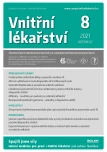Acute searching and early diagnosis of HCV infected persons
Authors:
Petr Husa ml.; Petr Husa
Authors‘ workplace:
Klinika infekčních chorob Lékařské fakulty MU Brno a FN Brno
Published in:
Vnitř Lék 2021; 67(8): 455-458
Category:
Review Articles
Overview
Hepatitis C virus (HCV) infection is still a major cause of chronic liver diseases, with approximately 71 million chronically infected persons worldwide. People who inject drugs currently or in the past (PWID), mostly intravenously, are the main risk group among HCV chronically infected persons. The efficacy of therapy with direct-acting antivirals (DAA) is almost 100 %. Currently, the main mission is to diagnose HCV infection in the most possible number of infected persons; it is in collision with poor adherence of PWID in particular. Changing the spectrum of chronic hepatitis C patients forces medical professionals to change their approach to diagnosis and treatment of HCV infection. Outreach testing and cooperation with support organizations showed to be an effective way to set a course to eliminate HCV in the PWID population.
Keywords:
chronic hepatitis C – HCV elimination – outreach screening
Sources
1. EASL recommendations on treatment of hepatitis C: final update of the series. CPG HCV. J Hepatol 2020; https://doi.org/10.1016/j.jhep.2020. 08. 018.
2. World Health Organization. Guidelines for the screening, care and treatment of persons with chronic hepatitis C infection. Updated version 2019. Dostupné na: https://www.who. int/news‑room/ fact‑sheets/ detail/hepatitis‑c.
3. Selvapatt N, Ward T, Harrison L, Lombardini J, Thursz M, McEwan P, Brown A. The cost impact of outreach testing and treatment for hepatitis C in an urban Drug Treatment Unit. Liver Int Off J Int Assoc Study Liver. 2017 Mar; 37 (3):345–353. PMID: 27566283
4. Kim H, Guerrero R, Reader SW, Daheri M, Balakrishnan M, Troisi CL, El‑Serag HB, Thrift AP. Low Yield of Hepatitis C Infection in an Outreach Screening Program in Harris County, Texas. Open Forum Infect Dis [Internet]. 2020 Jul 1 [cited 2021 Jan 31]; 7(ofaa191). Available from: https://doi.org/10.1093/ofid/ofaa191
5. Husa P ml, Husa P. Význam terénního testování v eliminaci hepatitidy C. Klin mikrobiol inf lék 2021; 27 (1): 13-17.
6. Acero Fernández D, Ferri Iglesias MJ, Buxó Pujolràs M, López Nuñez C, Serra Matamala I, Queralt Molés X, Aldeguer Manté X. Changes in the epidemiology and distribution of the hepatitis C virus genotypes in North‑Eastern Spain over the last 35 years. Gastroenterol Hepatol. Elsevier; 2018 Jan 1; 41(1): 2–11.
7. Krekulová L, Řehák V, Strunecký O, Nĕmeček V. Current Situation and Trends in the Hepatitis C Virus Genotype Distribution among Injecting Drug Users in the Czech Republic. Epidemiol Mikrobiol Imunol 2009; 58 (1): 84–89.
8. Kim H, Guerrero R, Reader SW, Daheri M, Balakrishnan M, Troisi CL, El‑Serag HB, Thrift AP. Low Yield of Hepatitis C Infection in an Outreach Screening Program in Harris County, Texas. Open Forum Infect Dis [Internet]. 2020 Jul 1 [cited 2021 Jan 31]; 7(ofaa191). Available from: https://doi.org/10.1093/ofid/ofaa191
9. Hůlek P, Urbánek P, et al. Hepatologie: 3. vydání 2018. Praha: Grada Publishing, a. s.; 2018.
10. Minola E, Prati D, Suter F, Maggiolo F, Caprioli F, Sonzogni A, Fraquelli M, Paggi S, Conte D. Age at infection affects the long‑term outcome of transfusion‑associated chronic hepatitis C. Blood. 2002 Jun 15; 99(12): 4588–4591. PMID: 12036892
11. de Oliveira AC, Bortotti AC, Nunes NN, El Bacha IAH, Parise ER. Association between age at diagnosis and degree of liver injury in hepatitis C. Braz J Infect, DiS. 2014 Sep 1; 18(5): 507–511.
12. Pawlotsky J‑M, Negro F, Aghemo A, Berenguer M, Dalgard O, Dusheiko G, Marra F, Puoti M, Wedemeyer H. EASL recommendations on treatment of hepatitis C: Final update of the series. J Hepatol. 2020 Nov 1; 73(5): 1170–1218.
Labels
Diabetology Endocrinology Internal medicineArticle was published in
Internal Medicine

2021 Issue 8
Most read in this issue
- SGLT2 inhibitors – a new pillar for the treatment of heart failure
- Renal parenchymal hypertension: relevant new aspects
- Optimal potassium levels in patients with heart failure
- Antibiotic treatment issues in patients with COVID-19
